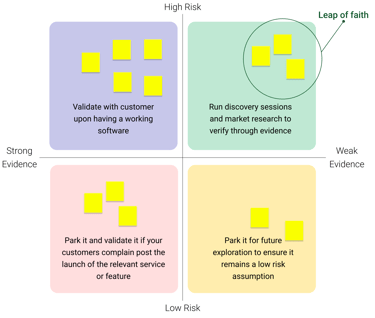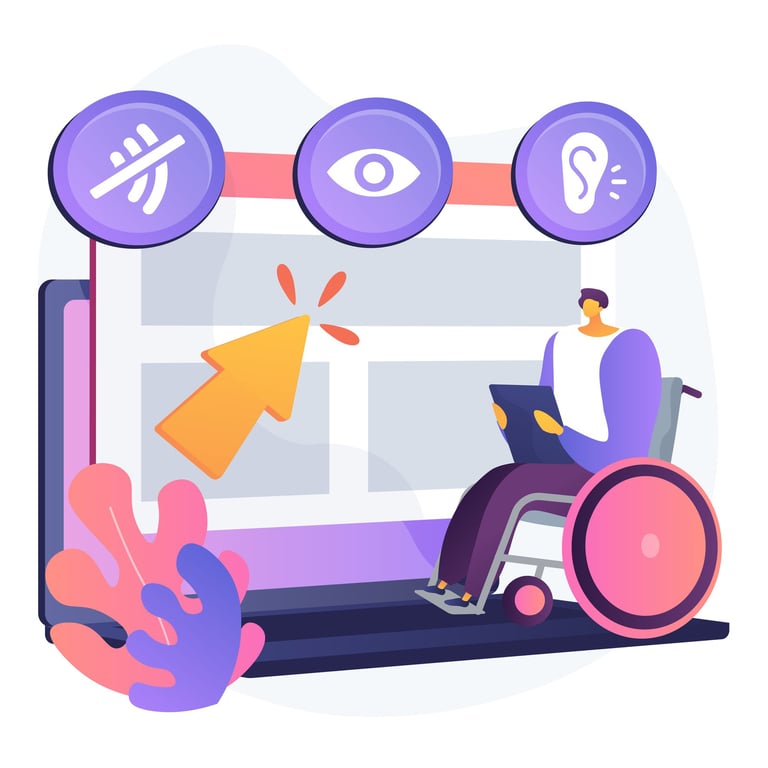Assumptions
Learn how assumptions play a crucial role in developing a successful product strategy
Assumptions are ways to capture your beliefs and findings based on observations or market study. They are key to formulating a successful product strategy. Hence, construct assumptions and test them via continuous discovery processes to evolve your business model and products. They play a crucial role in various stages of product development, from ideation to launch and beyond. They help guide decision-making and strategy, but it's essential to validate them to reduce risk and improve the chances of success. This blog Contain two key sections, Assumptions classification and Assumptions prioritisation framework.
Assumptions in Desirability
Desirability assumptions pertain to the belief that a product or service is wanted or needed by a target audience. These assumptions include customer preferences, behaviors, and emotional responses. For example, an assumption might be that a new app will appeal to tech-savvy millennials. If untested, such assumptions can lead to products that fail to attract or retain users. Conducting market research, surveys, and user testing helps validate these assumptions, ensuring the product truly meets user needs and desires. Key desirability assumptions include:
Assumptions in Accessibility
Accessibility assumptions relate to the belief that a product or service can be easily used by all intended users, including those with disabilities. These include assumptions about the usability of the product interface and the availability of necessary technology among users. For instance, assuming all users have high-speed internet can exclude those in rural areas. To address these assumptions, inclusive design principles and accessibility testing are essential. This ensures the product is usable by people with varying abilities and technological resources. These assumptions can impact user inclusivity and overall product reach. Key accessibility assumptions include:
Assumptions in Viability
Viability assumptions are about the long-term sustainability and profitability of a product or service. These include assumptions regarding market size, competitive landscape, and revenue models. For example, assuming a large market demand without sufficient market analysis can lead to overinvestment. Validating these assumptions involves thorough market research, competitive analysis, and financial modeling. This helps in understanding whether the business can maintain profitability and growth over time. Key viability assumptions include:
Assumptions in Feasibility
Feasibility assumptions concern the practical ability to develop and deliver a product or service. These include assumptions about technical capabilities, resources, and timelines. An example is assuming that a new feature can be developed within a short timeframe without considering potential technical challenges. To validate feasibility assumptions, project planning, prototyping, and resource assessment are critical. This ensures that the project is technically possible and can be delivered within constraints. From a digital product management perspective, key feasibility assumptions include:
Assumptions in Usability
Usability assumptions are beliefs about how users will interact with a digital product and how intuitive and easy-to-use they will find it. These assumptions, if untested, can lead to design flaws and poor user experiences. From a digital product management perspective, key usability assumptions include:
Assumptions in Scalability
Scalability assumptions are beliefs regarding a digital product's ability to handle increased loads, users, or data without performance degradation. These assumptions focus on non-functional requirements, which define system attributes such as performance, reliability, and maintainability. Unfortunately this is viewed with least importance by startups which are in a hurry to get their product to the market, only later to be stalemated by their own short sighted system architecture. Below are a few key assumptions on scalability to consider for startups and design solutions around it :
Emotional Connection: Assuming that users will form an emotional connection with the product, leading to loyalty and advocacy. This includes beliefs about how the product aligns with user values and lifestyle. Testing these assumptions involves gathering qualitative feedback and observing user interactions with the product.
Market Trends: Assuming the product aligns with current market trends and user expectations. This involves keeping up-to-date with industry trends and competitor offerings. Regular market analysis and trend monitoring are crucial to validate these assumptions and ensure the product remains relevant.
User Behavior: Assuming users will adopt and integrate the product into their daily routines. This includes beliefs about user engagement and habitual use. Validating these assumptions requires behavioral studies, user journey mapping, and pilot testing to observe real user behaviour.
Value Proposition: Assuming the product's value proposition is compelling enough to attract and retain users. This involves assumptions about the unique benefits and advantages the product offers. Testing the value proposition through A/B testing, MVP (Minimum Viable Product) launches, and user feedback helps ensure it resonates with the target audience.
By rigorously validating these desirability assumptions through comprehensive user research, market analysis, and iterative testing, digital product managers can ensure their product meets user expectations and achieves market success.
1. Assumptions Classification
User Capabilities: Assuming all users can interact with the product without assistive technologies. This overlooks the needs of users with visual, auditory, motor, or cognitive impairments. Ensuring accessibility involves designing for screen readers, keyboard navigation, and other assistive technologies.
Technology Access: Assuming all users have access to the latest devices and high-speed internet. This may exclude users with older devices or slower connections. Designing for a range of devices and optimizing for various speeds ensures broader accessibility.
Usability Standards: Assuming that following basic usability guidelines automatically makes the product accessible. Accessibility requires adherence to specific standards like WCAG (Web Content Accessibility Guidelines), which address various disability needs comprehensively.
User Testing: Assuming that typical user testing covers all accessibility needs. Involving users with disabilities in testing phases helps identify and address unique challenges they may face.
Statistical Underestimation: Assuming the impact of disabilities on the user base is minimal. According to the World Health Organization, over 1 billion people, or about 15% of the global population, live with some form of disability. In the U.S., the Centers for Disease Control and Prevention reports that 26% of adults have some type of disability.
By critically evaluating and validating these accessibility assumptions through inclusive design, adherence to standards, and comprehensive user testing, digital product managers can create products that are accessible to all users, enhancing overall user experience and expanding market reach.
By validating these viability assumptions through detailed research, financial analysis, and continuous market feedback, digital product managers can ensure their product is not only feasible but also sustainable and profitable in the long term.
Market Demand: Assuming there is sufficient market demand for the product. Validating this requires market research, competitive analysis, and customer feedback to ensure a real need exists.
Revenue Streams: Assuming the proposed revenue models will generate expected income. This includes beliefs about pricing, customer willingness to pay, and sales volume. Financial modeling and pilot programs help confirm these assumptions.
Cost Structure: Assuming operational and development costs are manageable and aligned with revenue projections. Regular cost analysis and budgeting ensure these assumptions are realistic.
Competitive Advantage: Assuming the product offers a unique value proposition that differentiates it from competitors. Competitive analysis and value proposition testing validate this assumption.
Scalability of Business Model: Assuming the business model can scale as the product grows. This involves assumptions about market expansion, resource scaling, and operational efficiency. Testing scalability through phased rollouts and feedback loops is essential.
Regulatory and Compliance Factors: Assuming the product will meet all regulatory requirements and industry standards. Conducting thorough regulatory reviews and compliance checks ensures this assumption holds true.
Technical Capabilities: Assuming the existing technology stack and team skills are sufficient to build the product as envisioned. For example, believing that the current infrastructure can support new features without significant upgrades. To validate this, product managers should conduct technical assessments, prototyping, and consult with development teams to ensure the necessary capabilities are in place.
Resource Availability: Assuming that the necessary resources (e.g., developers, designers, budget) are available and can be allocated to the project. This includes assumptions about team capacity and expertise. Effective resource planning and regular reassessment of resource availability are essential to confirm these assumptions.
Timeline Realism: Assuming that the product can be developed within the proposed timeline. This involves beliefs about the complexity of tasks, potential roadblocks, and the efficiency of development processes. To validate timeline assumptions, product managers should create detailed project plans, set realistic milestones, and use agile methodologies to adapt to changes and unforeseen challenges.
Budget Constraints: Assuming that the project can be completed within the allocated budget. This includes assumptions about development costs, operational expenses, and contingency funds. Regular financial reviews and cost-benefit analyses help ensure that budget assumptions are realistic and that any potential overruns are identified early.
Third-Party Dependencies: Assuming that third-party services, APIs, or vendors will perform as expected without issues. For example, believing that an external API will remain reliable and performant. To mitigate risks, product managers should evaluate the reliability of third-party services, have contingency plans in place, and regularly monitor their performance.
Scalability and Future Growth: Assuming that the product will be able to scale and accommodate future growth without significant rework. This includes beliefs about the product's architecture and design. Validating these assumptions involves conducting scalability testing, ensuring modular and flexible architecture, and planning for future enhancements.
By critically evaluating and validating these feasibility assumptions through thorough planning, testing, and continuous feedback, digital product managers can ensure that their products are not only viable but also delivered efficiently and effectively within constraints.
Performance: Assumptions about performance might include the belief that the system can maintain response times under heavy user loads. For instance, assuming that doubling the user base will not affect system speed can be risky without proper stress testing.
Reliability: Reliability assumptions involve the system's ability to operate without failure over a specific period. This includes assumptions about uptime, fault tolerance, and disaster recovery. Assuming a system will be available 99.9% of the time without considering potential points of failure or redundancy plans can lead to significant issues.
Maintainability: Maintainability assumptions relate to the ease with which the system can be updated or modified. This includes assumptions about the modularity of code, ease of bug fixes, and system upgrades. Assuming that the system will be easy to maintain without a robust architecture or proper documentation can result in technical debt and high maintenance costs.
Scalability of Infrastructure: This involves assumptions about the capability of the underlying infrastructure to scale. For instance, assuming cloud infrastructure will seamlessly scale without understanding the cost implications or potential bottlenecks can be problematic.
Capacity Planning: Assumptions here might include beliefs about storage, network bandwidth, and computational resources required as the system grows. Assuming existing capacity will suffice without thorough analysis and forecasting can lead to resource shortages and system failures.
To validate scalability assumptions, it's crucial to conduct performance testing, load testing, and capacity planning. Regular monitoring and feedback loops ensure that the system can scale effectively, meeting the non-functional requirements even as demands increase.
By critically examining and validating these usability assumptions through rigorous testing and user feedback, digital product managers can create products that are truly user-centric, enhancing satisfaction, engagement, and overall success.
User Familiarity: Assuming users are familiar with certain design patterns and interactions. For example, believing that users will understand a hamburger menu or swipe gestures without explanation. To validate this, it's important to conduct usability testing with a diverse user base to ensure all users can navigate the product intuitively.
Ease of Task Completion: Assuming users will easily complete tasks without encountering difficulties. This might involve assumptions about the clarity of navigation, form fields, or the steps in a process. Testing these tasks with real users can reveal unexpected pain points and areas for improvement.
Consistency in Behavior: Assuming that users will behave consistently across different contexts and devices. For example, assuming users will interact with a mobile app in the same way they do with a web application. Cross-platform usability testing helps identify inconsistencies and ensures a seamless user experience.
Error Handling: Assuming users will understand and recover from errors on their own. This includes assumptions about the clarity and helpfulness of error messages. To address this, product managers should test how users handle errors and ensure that error messages are informative and guide users towards a resolution.
Satisfaction and Engagement: Assuming users will find the product engaging and enjoyable to use. This involves beliefs about the visual design, content, and overall user experience. Gathering qualitative feedback through surveys, interviews, and usability tests helps validate these assumptions and align the product with user expectations.
Accessibility Awareness: Assuming all users have similar abilities and access to technology. This might involve overlooking the needs of users with disabilities or those using assistive technologies. Conducting accessibility testing and adhering to accessibility guidelines ensures that the product is usable by everyone, regardless of their abilities.
One of the many takeaways from the amazing book on Product Management, 'Continuous Discovery Habits' by Teresa Torres, was the Assumption prioritisation framework. Originally designed by David J, Bland, author of testing Business Ideas, is a simple and effective to prioritise assumptions which needs to be tested at the earliest. But we have modified the Y-axis to asses the 'Risk' if the assumption goes wrong rather than the 'Importance' of the assumption. We understand that 'Risk' is comparatively perceived with seriousness and urgency over the word 'Importance' in the product and project management disciplines. It also directly reminds the team of the 'Cost of Delays' they will run into if the respective assumption testifies to be wrong.
Avoid the anti-patterns of Cognitive biases while writing assumptions. Write assumptions in positive frame and not in a negative frame, a positive frame helps the team understand the belief and what to test in the right sense.
For example
Right way : Customers will share their personal data to receive special offers
To avoid : Customers will not share their personal data to receive special offers
Each assumption shall be placed on the quadrant relative to one another. For example take an assumption that the team unilaterally agrees as 'High on Evidence' and 'High Risk' meaning the assumption is supported with data from customer interviews and market research. We only need to validate these assumptions once the prototype or the feature is put to the hands of the customer before closing the assumption.
Now compare the rest of the assumptions you have collected to this assumption and place it across the quadrants. We can always redo the exercise at regular intervals as we run our continuous discovery sessions, so at first attempt do not burn all your time to make it accurate.






While collecting evidence it is important to know the difference between 'Verification' and 'Validation', Verification is about supporting an assumption with data collected from market research during ideation and in the course of product development and its the Validation that ensures your final product meets the user's needs and expectations and performs its intended functions in the real-world environment.










2. Assumptions Prioritisation Framework


Conclusion
In conclusion, assumptions are an integral part of product development, influencing decisions from ideation to launch. By addressing assumptions in areas such as desirability, accessibility, viability, feasibility, usability, scalability, and accessibility, product managers can navigate uncertainties and guide their teams effectively.
By critically evaluating and validating assumptions, product teams can reduce risks, make informed decisions, and enhance the chances of delivering successful, user-centric products. Embracing a structured approach to assumptions not only ensures product alignment with market needs but also fosters innovation and continuous improvement.



